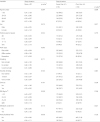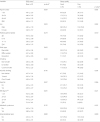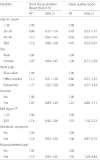1. Erikki K, Timo P, Tiina L, Markku P, Mikko H, Christer H, et al. Trends in self-reported sleep duration and insomnia-related symptoms in Finland from 1972 to 2005: a comparative review and re-analysis of Finnish population samples. J Sleep Res. 2008; 17:54–62. DOI:
10.1111/j.1365-2869.2008.00627.x. PMID:
18275555.

3. Cho YW, Shin WC, Yun CH, Hong SB, Kim JH, Earley CJ. Epidemiology of insomnia in Korean adults: prevalence and associated factors. J Clin Neurol. 2009; 5(1):20–23. DOI:
10.3988/jcn.2009.5.1.20. PMID:
19513329.

4. Kim YG, Yoon DY, Kim JI, Chae CH, Hong YS, Yang CG, et al. Effects of health on shift-work: general and psychological health, sleep, stress, quality of life. Korean J Occup Environ Med. 2002; 14(3):247–256.

5. Kim MG, Lee WC, Lee YM, Ryoo JH, Kim HC, Yoo SW, et al. Factors associated with quality on sleep of subway workers by shift-work. Korean J Occup Environ Med. 2008; 20(4):326–334.

6. Son M. The relationship of working hours and work intensity with sleep disturbance among continuous 12 hours day and night shift workers in an automobile factory in Korea. Korean J Occup Environ Med. 2003; 16(1):13–24.
7. Linton SJ, Bryngelsson IL. Insomnia and its relationship to work and health in a working-age population. J Occup Rehabil. 2000; 10:169–183. DOI:
10.1023/A:1009408204694.
8. Keith P, Stefania D, Clare H, Cathy L, Avan AS, Catharine G, et al. Sleep disturbance and the older worker: findings from the health and employment after fifty study. Scand J Work Environ Health. 2017; 43(2):136–145. DOI:
10.5271/sjweh.3618. PMID:
28052164.
9. Expert panel on detection, evaluation, and treatment of high blood cholesterol in adults. Executive summary of the third report of the national cholesterol education program (NCEP) expert panel on detection, evaluation, and treatment of high blood cholesterol in adults (adult treatment panel III). JAMA. 2001; 285(19):2486–2497. DOI:
10.1001/jama.285.19.2486. PMID:
11368702.
11. Sohn SI, Kim DH, Lee MY, Cho YW. The reliability and validity of the Korean version of the Pittsburgh sleep quality index. Sleep Breath. 2012; 16(3):803–812. DOI:
10.1007/s11325-011-0579-9. PMID:
21901299.

12. Buysee DJ, Reynolds CF 3rd, Monk TH, Berman SR, Kupfer DJ. The Pittsburgh sleep quality index: a new instrument for psychiatric practice and research. Psychiatry Res. 1989; 28(2):193–213. DOI:
10.1016/0165-1781(89)90047-4. PMID:
2748771.
13. Doe J. National Institute for Occupational Safety and Health (NIOSH) in: musculoskeletal disorders and workplace factors: a critical review of epidemiologic evidence for work-related musculoskeletal disorders of the neck, upper extremity, and low back. Ctr Dis Control Prev. 1997;
https://www.cdc.gov/niosh/docs/97-141/pdfs/97-141.pdf. Accessed 24 July 2017.
14. Cappuccio FP, D'Elia L, Strazzullo P, Miller MA. Sleep duration and all-cause mortality: a systematic review and meta-analysis of prospective studies. Sleep. 2010; 33(5):585–592. DOI:
10.1093/sleep/33.5.585. PMID:
20469800.

15. Doe J. Morbidity and mortality weekly report. Short sleep duration among workers-United States, 2010. Centers for Disease Control and Prevention. 2012.
17. Barros AJ, Hirakata VN. Alternatives for logistic regression in cross-sectional studies: an empirical comparison of models that directly estimate the prevalence ratio. BMC Med Res Methodol. 2003; 3:21. DOI:
10.1186/1471-2288-3-21. PMID:
14567763.

18. Coutinho LM, Scazufca M, Menezes PR. Methods for estimating prevalence ratios in cross-sectional studies. Rev Saude Publica. 2008; 42(6):992–998. DOI:
10.1590/S0034-89102008000600003. PMID:
19009156.
19. Nijem K, Kristensen P, Al-Khatib A, Bjertness E. Application of different statistical methods to estimate relative risk for self-reported health complaints among shoe factory workers exposed to organic solvents and plastic compounds. Norsk Epidemiologi. 2005; 15(1):111–116.

20. Lee MS, Shin JS, Lee J, Lee YJ, Kim MR, Park KB, et al. The association between mental health, chronic disease and sleep duration in Koreans: a cross-sectional study. BMC Public Health. 2015; 15:1200. DOI:
10.1186/s12889-015-2542-3. PMID:
26627637.

21. Sohn CH, Kim MS, Kim HJ, Kim SY, Lee JH, Jhun HJ, et al. Sleep patterns and morning heart rate variability among daytime workers in Korea. Korean J Occup Environ Med. 2005; 17(3):208–215.

22. Kim CW, Chang YS, Zhao D, Cainzos-Achirica M, Ryu SH, Jung HS, et al. Sleep duration, sleep quality, and markers of subclinical arterial disease in healthy men and women. Arterioscler Thromb Vasc Biol. 2015; 35(10):2238–2245. DOI:
10.1161/ATVBAHA.115.306110. PMID:
26359509.

23. Michiaki N, Satoshi H, Kazuomi K. Sleep duration as a risk factor for cardiovascular disease- a review of the recent literature. Curr Cardiol Rev. 2010; 6(1):54–61. DOI:
10.2174/157340310790231635. PMID:
21286279.
24. Gangwisch JE, Heymsfield SB, Boden-Albala B, Buijs RM, Kreier F, Pickering TG, et al. Short sleep duration as a risk factor for hypertension analyses of the first national health and nutrition examination survey. Hypertension. 2006; 47:833–839. DOI:
10.1161/01.HYP.0000217362.34748.e0. PMID:
16585410.
25. Kim KW, Chung EK, Park HD, Kim KB, Kang JK, Ro JW, et al. Differences in sleep quality and fatigue according to gender of shift workers in electronics manufacturing industries. J Korean Soc Occup Environ Hyg. 2017; 27(2):138–148.
26. Madrid-Valeroa JJ, Martinez-Selva JM, Ribeiro do Couto B, Sánchez-Romera JF, Ordoñana JR. Age and gender effects on the prevalence of poor sleep quality in the adult population. Gac Sanit. 2017; 31(1):18–22. DOI:
10.1016/j.gaceta.2016.05.013. PMID:
27474487.
27. Walter M, Ronaldo P, Dalva P, Lia Rita B, Rogelio Santos S, Sergio T. Effects of aging on sleep structure throughout adulthood: a population-based study. Sleep Med. 2014; 15(4):401–409. DOI:
10.1016/j.sleep.2013.11.791. PMID:
24657204.
28. Ohayon MM, Mary AC, Christian G, Micheal VV. Meta-analysis of quantitative sleep parameters from childhood to old age in healthy individuals: developing normative sleep values across the human lifespan. Sleep. 2004; 27:1255–1273. DOI:
10.1093/sleep/27.7.1255. PMID:
15586779.

29. Doi Y, Minowa M, Tango T. Impact and correlates of poor sleep quality in Japanese white-collar employees. Sleep. 2003; 26(4):467–471. DOI:
10.1093/sleep/26.4.467. PMID:
12841374.

30. Gardie A, Shafto M, Leng Y, Kievit RA; CAM-CAN. How are age related differences in sleep quality associated with health outcomes? An epidemiological investigation in a UK cohort of 2406 adults. BMJ Open. 2017; 7:e014920. DOI:
10.1136/bmjopen-2016-014920.
31. Pilcher JJ, Ginter DR, Sadowsky B. Sleep quality versus sleep quantity: relationships between sleep and measures of health, well-being and sleepiness in college students. J Psychosom Res. 1997; 42(6):583–596. DOI:
10.1016/S0022-3999(97)00004-4. PMID:
9226606.

32. Ryou HC, Kong JO, Lee HK, Lee SJ, Cho SH, Jung YH, et al. The comparison of job stress factors, psychosocial stress and their association between research and manufacturing workers in an automobile research and developing company. Korean J Occup Environ Med. 2009; 21(4):337–345.

33. Cappuccio FP, Taggart FM, Kandala NB, Currie A, Peile E, Stranges S, Miller MA. Meta-analysis of short sleep duration and obesity in children and adults. Sleep. 2008; 31(5):619–626. DOI:
10.1093/sleep/31.5.619. PMID:
18517032.

34. Meyer KA, Wall MM, Larson NI, Laska MN, Neumark-Sztainer D. Sleep duration and BMI in a sample of young adults. Obesity. 2012; 20(6):1279–1287. DOI:
10.1038/oby.2011.381. PMID:
22282051.

35. Ko SB. Night shift work, sleep quality, and obesity. J Lifestyle Med. 2013; 3(2):110–116. PMID:
26064847.
36. Kazuo O, Gilles JL, Nelly H, Christiane M, Daniel F, Jacques YM. Comparison of sleep variables between chronic widespread musculoskeletal pain, insomnia, periodic leg movements syndrome and control subjects in a clinical sleep medicine practice. Sleep Med. 2008; 9(4):352–361. DOI:
10.1016/j.sleep.2007.07.007. PMID:
17804292.
37. Alsaadi SM, McAuley JH, Hush JM, Lo S, Lin CW, Williams CM, et al. Poor sleep quality is strongly associated with subsequent pain intensity in patients with acute low back pain. Arthritis Rheumatol. 2014; 66(5):1388–1394. DOI:
10.1002/art.38329. PMID:
24782195.

38. Lim DK, Baek KO, Chung IS, Lee MY. Factors related to sleep disorders among male firefighters. Korean J Occup Envron Med. 2014; 26:11.

39. Tekoglu I, Ediz L, Hiz O, Toprak M, Yazmalar L, Karaaslan G. The relationship between shoulder impingement syndrome and sleep quality. Eur Rev Med Pharmacol Sci. 2013; 17:370–374. PMID:
23426540.
40. Lee H, Sue W, Marcus RM. Exploring the associations between sleep problems and chronic musculoskeletal pain in adolescents: a prospective cohort study. Pain Res Manag. 2014; 19(5):e139–e145. DOI:
10.1155/2014/615203. PMID:
25299477.








